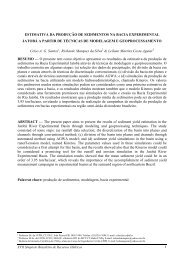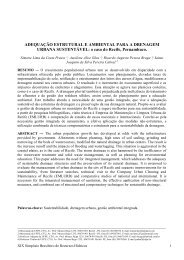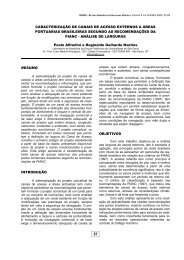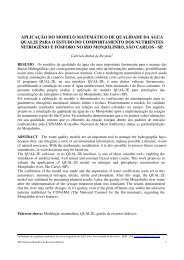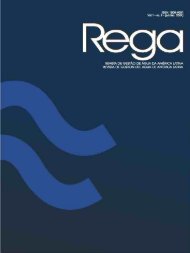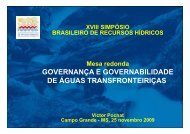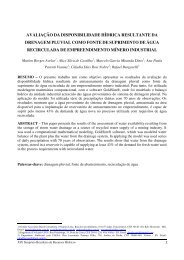Rega-17 (sem issn) - Cepal
Rega-17 (sem issn) - Cepal
Rega-17 (sem issn) - Cepal
- No tags were found...
You also want an ePaper? Increase the reach of your titles
YUMPU automatically turns print PDFs into web optimized ePapers that Google loves.
○ ○ ○ ○ ○ ○ ○ ○ ○ ○ ○ ○ ○ ○ ○ ○ ○ ○ ○ ○ ○ ○ ○ ○ ○ ○ ○ ○ ○ ○ ○ ○ ○ ○ ○ ○ ○ ○ ○ ○ ○ ○ ○ ○ ○ ○ ○ ○ ○ ○ ○ ○REGA – Vol. 1, no. 1, p. 37-46, jan./jun. 200438sus in the formulation of a new Politica y Ley deAguas para Bolivia (policy and water legislationfor Bolivia).This case study highlights what can go wrongin badly implemented privatisations or waterreforms, but it also illustrates how civil societycan organise to represent their interests, and whyand how representative participation can be encouraged.These are important lessons for organisationsseeking to increase their involvementin integrated water resources managementacross the world, and agencies seeking to improveparticipation and representationKEY WORDS: Policies, legislation, water rights,social organizations, privatisation, participation,water and sanitation.va Política y Ley de Aguas para Bolivia.Este estudio de caso destaca los problemas quepueden originarse de privatizaciones o reformasmal implementadas en el sector de recursos hídricos,además de ilustrar las maneras en que lasociedad civil puede organizarse para representarsus intereses y las razones y maneras comopuede incentivarse la participación representativa.Son lecciones importantes para organizacionesque tratan de aumentar su participación enla gestión integrada de los recursos hídricos entodo el mundo, y agencias que desean mejorarsus formas de participación y representación.PALABRAS CLAVE: Políticas, legislación, derechosdel agua, organizaciones sociales, privatización,participación, agua y saneamiento.INTRODUCTIONThis case study highlights the importanceof social and community participation in thedevelopment of regulations, managementrules, policies and institutions in relation tothe management water resources and the provisionof water and sanitation services, and whatcan go wrong when these processes are absentor flawed. Possibly, the conflict could have beenavoided if the reform process had involvedstrong participation, dialogue and agreementbetween all the parties involved. On the otherhand, the case illustrates how a combinationof negotiation and social mobilization aroundpositive proposals can lead to important changesin politics and legislation at national level.In Bolivia there are marked differences andinequalities in access to water between urbanand rural areas, and between different locations.The city of Cochabamba (the Cercado) (Figure1) has approximately 470,000 inhabitants (76%of the total population in the department), andonly 55% of people are covered by drinkingwater services. According to a study carried byNickson and Vargas (2001), the poorest sectorsof the population are in general the most deprivedof services. The provision of water andsanitation services was (and is now again) a responsibilityof the Servicio Municipal de Agua Potabley Alcantarillado (Drinking Water and SewageMunicipal Service) or SEMAPA, a municipalpublic concern, with autonomous administrationand its own assets.Cochabamba is located in a valley where thescarcity of water has generated conflicts over along period. In fact, some of the first judicialcases during colonial times were related towater disputes. The most recent conflict startedduring the sixties, when the recently establishedSEMAPA carried out the first attemptsto drill water wells in the Central Valley, aimedBACKGROUND





